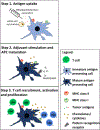Vaccine Strategy in Melanoma
- PMID: 31079792
- PMCID: PMC6763732
- DOI: 10.1016/j.soc.2019.02.003
Vaccine Strategy in Melanoma
Abstract
The incidence of melanoma continues to increase even as advances in immunotherapy have led to survival benefits in advanced stages. Vaccines are capable of inducing strong, antitumor immune responses with limited toxicity. Some vaccines have demonstrated clinical benefit in clinical trials alone; however, others have not despite inducing strong immune responses. Recent advancements have improved vaccine design, and combining vaccines with other immunotherapies offers promise. This review highlights the underlying principles of vaccine development, common components of vaccines, and the remaining challenges and future directions of vaccine therapy in melanoma.
Keywords: Melanoma; Neoantigen; T cell; Tumor-associated antigen; Vaccine; Vaccine adjuvant.
Copyright © 2019 Elsevier Inc. All rights reserved.
Figures



References
-
- Reynolds SR, Celis E, Sette A, et al. HLA-Independent Heterogeneity of CD8+ T Cell Responses to MAGE-3, Melan-A/MART-1, gp100, Tyrosinase, MC1R, and TRP-2 in Vaccine-Treated Melanoma Patients. The Journal of Immunology. 1998;161(12):6970–6976. - PubMed
Publication types
MeSH terms
Substances
Grants and funding
LinkOut - more resources
Full Text Sources
Medical

